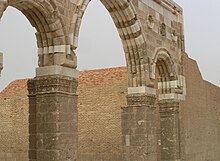Mshatta
Mshatta or Qasr Mshatta ( Arabic قصر المشتى, DMG qaṣr al-Mušattā 'Winter Palace') is an Umayyad or early Abbasid desert castle in Jordan and one of the most famous secular buildings of early Islamic art . It is located 30 km south of today's Jordanian capital Amman on the airport grounds of Queen Alia International Airport . Since 2001 it has been proposed as a UNESCO World Heritage Site .
history
The dating of the desert castle is uncertain, based on a passage in the chronicle of Sawirus ibn al-Muqaffa ' , however, it is often assumed that work on the palace began in the reign of Caliph al-Walid II (743-744). According to tradition, the caliph wanted to build an independent city. However, many forced laborers died during the construction, whereupon they revolted against him and killed him. His successor, Caliph Yazid III. , I had to swear not to build any more desert castles. Al-Walid's brief reign could also explain why the castle remained unfinished. The widespread assumption that this representation refers to Mshatta, however, was hypothetical and questioned early on by Jean Sauvaget. Alternatively, Oleg Grabar suggested dating to the early Abbasid period.
The building was probably badly damaged by an earthquake and then abandoned by its residents. The name Mschatta , translated "Winter Palace", comes from the Bedouins in the area. The name originally intended for the castle has not been passed down.
Construction
The surrounding wall had a square floor plan with an inner side length of 144 meters and was reinforced by 25 towers. The dimensions of the complex correspond to about twice that of a normal Umayyad palace and are only slightly smaller than the 160 meters side length of the fortress of Qasr al-Heir al-Sharqi, known as the “city” . The main wing of the palace contained the reception hall and the throne room. Some living rooms are grouped around this. A mosque was also part of the palace. The building remained unfinished: Originally, two more components were to be completed.
Due to the central location of the administrative premises and the marginalized residential complexes, the representative character of the castle is in the foreground, while the other Umayyad desert castles in the area served the caliphs mainly or exclusively as a residence.
facade

Since the facade was in the immediate vicinity of the construction site of the Hejaz Railway , it was feared that valuable components could be stolen from the cultural monument . The facade of the main gate, the Mshatta facade , was therefore given to Kaiser Wilhelm II by Sultan Abdülhamid II , mediated by the Arabia researcher Julius Euting . The Hejaz Railway then enabled the facade to be removed without any problems. It ended up in various Berlin museums one after the other and can now be viewed in the Museum of Islamic Art in the Pergamon Museum .
reconstruction
Since 2009, the Technical University of Berlin has been working with the Jordanian Antiquities Administration and the Berlin State Museums to secure and partially reconstruct the palace. The three arches of the entrance portal were rebuilt, whereby for the most part original stones could be used. Most of the runners of the western enclosure wall were lost due to stone robbery , so they had to be replaced. The reconstruction work should be completed in 2012 with the erection of the entrance arch to the audience hall. The project is financed by the German Research Foundation and the Federal Foreign Office.
literature
- Johannes Cramer, Barbara Perlich and Günther Schauerte with Ghazi Bisheh, Claus-Peter Haase, Monther Jamhawi and Fawwaz al-Kreisheh (eds.): Qasr Al-Mschatta. An early Islamic palace in Jordan and Berlin , 2 volumes, Michael Imhof, Petersberg 2016, ISBN 978-3-7319-0296-6 .
- Robert Hillenbrand : Islamic Art at the Crossroads: East versus West at Mshattā. In: Ders .: Studies in Medieval Islamic Architecture. Vol. I. The Pindar Press, London 2001 (first published in 1981)
- Bruno Schulz , Josef Strzygowski : Mschatta. Report on the recording of the ruin and an art-historical investigation. In: Yearbook of the Royal Prussian Art Collections 25, 1904, pp. 205–373.
- Leo Trümpelmann : Mschatta. A contribution to the determination of the art circle, the dating and the style of ornamentation. Max Niemeyer Verlag, Tübingen 1962.
- Frank Rainer Scheck: Jordan. Peoples and cultures between the Jordan and the Red Sea. DuMont, Cologne 2000, ISBN 3770139798 , pp. 225-227.
Web links
- Search for Mschatta in the German Digital Library
- Search for Mschatta in the SPK digital portal of the Prussian Cultural Heritage Foundation
- Project website of the TU Berlin
- Desert Castles Tour (Universes in Universe - Worlds of Art)
Individual evidence
- ↑ Qasr Mshatta on the UNESCO World Heritage Site
- ^ Oleg Grabar: Early Islamic Art, 650-1100. Constructing the Study of Islamic Art. Ashgate Publishing Limited, Hampshire 2005, ISBN 0860789217 , p. 156.
- ↑ Julius Euting (1839–1913) ( Memento from August 27, 2007 in the Internet Archive ): Through J. Euting's mediation, part of the facade of the Mschatta desert castle came to Berlin as a gift from the Sultan to Kaiser Wilhelm II
- ^ Project website of the TU Berlin
Coordinates: 31 ° 44 ′ 15 ″ N , 36 ° 0 ′ 37 ″ E


